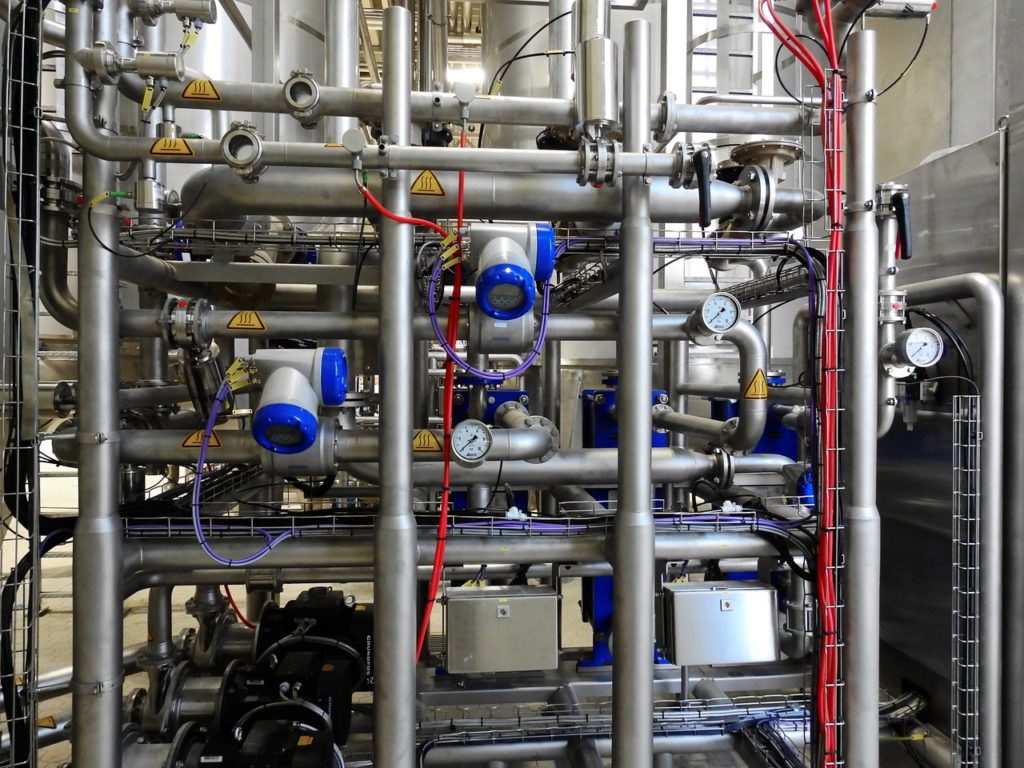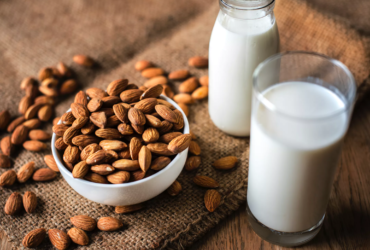By Bryan Quoc Le | 150 Food Science Questions Answered
Every morning, I made the hour-long drive through rural Wisconsin to get to my summer job at the cheese plant. I typically woke up with eyes wide shut, groping in the dark to turn off my alarm, and would be on the road by sunrise. I would watch with sleepy interest as the familiar green pastures and red barns passed me by.
My favorite part of the drive was watching the cows lazily chew their breakfast of hay and grass. Some would jump for joy with the fortune of having fresh air and food. Others would lay around in the mud, swatting away the swarming flies and waiting for mid-morning to come.
I would be humbled by the fact that simultaneously, this very scene was being replicated across the state of Wisconsin, with nearly 1.3 million cows being fed in that very same way every morning [1].
After their morning meal, these cows would be milked and their fresh milk shipped out in insulated cold trucks headed for producers of all things related to milk — butter, cream, dry milk, yogurt, and what have you.
But let’s not forget what Wisconsin is really all about — cheese.
And one of the big markets for cheese?
Pizza.
As I drove into the parking lot, I would see the looming milk silos attached to the cheese plant. Three times each day, thousands of gallons of milk would be pumped into these silos. And every day, thousands of pounds of low-moisture grade-A mozzarella would be freshly made from that same milk around the clock, destined for pizza ovens across the nation.

By Steyn Viljoen at Pexels
Bringing Together Cheese and Automation
All of the basic steps of cheese-making are still evident [2]. Milk is pasteurized, mixed with rennet — a bovine digestive enzyme used to coagulate milk proteins — and other proprietary ingredients, cooked until fully gelled, cut, salted, compressed into molds, and allowed to soak in ice-cold salt brine for days. The newly formed blocks are packaged and allowed to sit in refrigerated storage facilities until they’re ready to ship to downstream cheese processors and corporate customers.
The cheese plant is surprisingly modern and more akin to a chemical refinery than a food production facility. Stainless steel piping and equipment line every room. Automation can be found at every juncture, pump, and pipe joint.
Computer screens dot the corners of each operation, allowing operators and supervisors to survey and control every stage of the process, without ever moving from their seat. At a minimum, the entire operation of cheese production requires seven operators. A few decades ago, it would have taken 20 to 30 workers to do the same job.
The operators who run these positions have been here for decades. Many of them have seen the relatively rapid transition from manual to automated systems. The change has been mostly welcomed, as it has saved thousands of human-hours of backbreaking labor that includes ingredient adding, mixing, and sanitation steps.
Tasks can be performed from different parts of the plant, allowing the operator to take on auxiliary duties while maintaining their eye on their niche operations. But cheese-making has suddenly become a process of pushing touchscreens and reading digital graphs, tasks more in line with our younger, iPhone-wielding generation.
And while a good number of the older operators have their cheese-making license [3], hard-earned with years of study, their younger co-workers are no longer required to acquire such a license. Ask them how cheese is made, and they’ll stare at you with blank looks. The seasoned cheese veterans may look forward to their impending retirement, but it’s clear there’s a nostalgia about the way cheese used to be made, knowledge that’ll be lost when they move on.

By Brett Jordan at Pexels
The Economic Realities of the Industry
With market prices for commodity pizza cheese hovering around $1 per pound [4], every effort to cut costs becomes a necessity. This is mainly ensured by maintaining precise levels of proteins and moisture in the cheese — water is essentially free, while milk protein always costs money.
Commodity cheese plants face the harsh economic realities of production in a manner no different from the myth of Icarus. Bring the moisture levels too low, and the plant risks tanking into bankruptcy with the fluctuating cost (and protein quality) of milk. Fly too close to the upper legal limit for moisture [5], and their cheese will simply vaporize into oblivion in the fiery hot pizza ovens operated by their clients.
These kinds of realities drive the need for constant monitoring and readjustment. Endless reams of data are generated by computers and humans alike and pored over daily to ensure maximum productivity. Modern cheese-making requires a degree of statistical precision that simply isn’t in the human toolbox of skills.
And so automation will continue to make gains in the market place over human labor in the cheese industry. The role of the manager will remain, but with increasing focus on automated systems optimization. Already, a significant bulk of the work done by managing supervisors is to put out fires set by faulty computer programming or improve yield efficiency by tweaking production inputs through touch-screens.
Steady Labor Shortages
Ironically, a shortage of good, steady labor is another issue that cropped up in discussions around the water cooler [6]. Few young workers want to make a lifelong career out of their positions at the cheese plant. These workers see their elder co-workers who suffer from repetitive stress injuries, permanent scarring from accidental cuts, and even loss of body parts from lacerations.
The long-term prospects of working at a cheese plant are dim for these fresh workers, and so many are looking for opportunities elsewhere. Some are using their current employment as a short-term springboard for more lucrative work by going to trade or night school. Others simply drift in and out of the labor pool, trying to make in-roads in a hazy world rapidly transitioning into a fully-automated economy and uncertain of the next steps for future employment.
It’s understandable, especially given that their positions could be quickly made obsolete by ongoing improvements in manufacturing robotics and artificial intelligence.
Nonetheless, the cheese-makers, operators, and laborers who remain are still proud of their jobs. Much of the cheese produced at the plant will go on to feed their own families and communities, if only in an indirect way through the Byzantine process of national distribution.
And despite uncertainties in labor demand, a position in cheese production remains one of the best paid and stable jobs in the rural area, where many remain to stay close to family and their community rather move to the “big” cities of Madison or Milwaukee for more potential opportunities.
Some hold onto the aspiration of achieving management positions, with the promise of higher wages, more career mobility, and recognition from their peers. One worker even goes so far as to work 80-hour weeks for double and triple overtime, nearly approaching the coveted six-figure income.
At the end of the day, pizza cheese will continue to be produced to feed the endless swarms of global pizza consumers. The convenience afforded by fast food pizza chains and frozen pizza products, among other cheese-laden foods, will continue to drive the demand for this low-cost mozzarella cheese.
And promising markets in China [7], whose growing middle class is gaining a penchant for American pizza from the likes of Pizza Hut and Domino’s, will keep these pizza cheese producers in business for decades to come.
References
[1] Staff, Wisconsin Cheese. “Farm & Dairy Statistics.” Wisconsin Cheese, 22 Apr. 2019, www.wisconsincheese.com/media/facts-stats/farm-dairy-statistics.
[2] Meier, Jennifer. “Six Important Steps in Cheesemaking.” The Spruce Eats, The Spruce Eats, 31 May 2018, www.thespruceeats.com/important-steps-in-cheesemaking-591566.
[3] “Want To Make Cheese In Wisconsin? It’s Harder Than One Might Think.” Wisconsin Public Radio, 18 Apr. 2019, www.wpr.org/want-make-cheese-wisconsin-its-harder-one-might-think.
[4] “Cheese Costs Heading Down.” PMQ Pizza Magazine, www.pmq.com/January-2015/Cheese-costs-heading-down/.
[5] “CFR – Code of Federal Regulations Title 21.” Accessdata.fda.gov, U.S. Food & Drug Administration, 1 Apr. 2018, www.accessdata.fda.gov/scripts/cdrh/cfdocs/cfcfr/CFRSearch.cfm?fr=133.156.
[6] Lowrey, Annie. “Wages Are Low and Workers Are Scarce. Wait, What?” The Atlantic, Atlantic Media Company, 6 Feb. 2019, www.theatlantic.com/ideas/archive/2018/09/is-america-facing-a-labor-shortage/570649/.
[7] Archwamety, Rena. “Foodservice Fuels China’s Demand for Cheese Imports.” Cheese Market News, Quarne Publishing, www.cheesemarketnews.com/articlearch/passport/china.html.

Bryan Quoc Le | 150 Food Science Questions Answered
IFTSA VP of Digital and Social Media (2019-2020)
Bryan is the author of 150 Food Science Questions Answered (Rockridge Press, 2020) and a Ph.D. candidate in Food Science at University of Wisconsin-Madison studying the health effects of garlic and onion flavors. He received his B.S. and M.S. in Chemistry at the University of California, Irvine. In another life, he walked 2,000 miles from California to Louisiana in six months, and learned that eating tuna and peanut butter every day was not meant for the average human body. After he met his wife, he learned that there was more to good food than canned goods and smoothies. While not juicing onions and pressing garlic, Bryan likes to run half-marathons, discover interesting cuisines with his wife, and help entrepreneurs develop great food products.







Leave a Reply